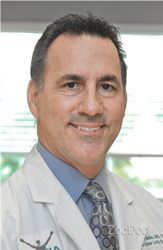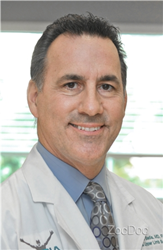
Dr. Alejandro Badia
the disorder is relatively common, but its diagnosis and the most effective methods for “thawing” the affected joint remain challenging. The exact cause is not exactly understood but its felt to have a hormonal and metabolic component in many cases.
MIAMI (PRWEB)
July 17, 2020
“Frozen.” It’s not simply the title of a popular family movie. It’s something that can happen to a shoulder joint – oftentimes for unknown reasons – resulting in stiffness, persistent pain and loss of range of motion. So, says orthopedic surgeon Alejandro Badia MD, an expert in treating problems of the upper limbs and joints and founder and chief medical officer of the Florida-based Badia Hand to Shoulder Center and founder of OrthoNOW®, a network of immediate care orthopedic centers. Dr. Badia notes that the disorder is relatively common, but its diagnosis and the most effective methods for “thawing” the affected joint remain challenging. The exact cause is not exactly understood but its felt to have a hormonal and metabolic component in many cases.
Symptoms of frozen shoulder often mimic other musculoskeletal problems, including tendinitis, arthritis and shoulder impingement, a more serious condition in which the rotator cuff tendon becomes inflamed and swells, causing sharp pain when lifting the arm. “Unlike frozen shoulder, which can gradually ease on its own, shoulder impingement must be addressed quickly to avoid permanent joint damage,” Dr Badia says.
“This is why it is so important for patients who experience any kind of shoulder pain that worsens over time to consult an orthopedic specialist – someone with the experience to accurately assess the problem and determine the optimal therapy,” emphasizes Dr. Badia.
Known in medical terms as adhesive capsulitis, frozen shoulder occurs when the connective tissue – or capsule – lining the shoulder cavity where the ball of the arm (humerus) bone fits into the shoulder blade socket becomes chronically inflamed. Scar tissue builds, causing the capsule to thicken, contract, and limit joint motion, according to the American Academy of Orthopaedic Surgeons. The disorder can develop in one or both shoulders, reportedly affects between 2 percent and 5 percent of the American population and may eventually resolve on its own – within 18-36 months or more.
Most at risk are individuals – primarily women – between the ages of about 40 and 65, patients who have diabetes and those who experience a shoulder injury, like torn rotator cuff, or develop chronic arthritis or other joint problem that restricts use of the shoulder, Dr. Badia says. In fact, statistics indicate that as many as 10 percent of patients treated for a rotator cuff problem will experience frozen shoulder.
Authors of a September 2019 article in Clinics in Orthopedic Surgery write that frozen shoulder, first described by French surgeon Simon-Emmanuel Duplay in 1872, has been “regarded as a self-limiting and benign disease with complete recovery of pain and range of motion.” However, the writers contend that studies show recovery can be a slow process, with a percentage of patients not fully recovered as much as five to 10 years following onset of their condition.
Dr. Badia concurs, indicating frozen shoulder can impact quality of life for years, limiting a person’s ability to perform routine tasks and participate in everyday activities.
The disorder generally proceeds through three phases: the initial “freezing” stage, in which pain develops in the shoulder and then worsens over time, sometimes even affecting a person’s sleep; a “frozen” state, when the pain may lessen, but the shoulder stiffens, making everyday activities difficult; and then the “thawing” phase, as shoulder motion gradually returns.
Frontline treatments for the disorder are conservative, consisting of oral, anti-inflammatory medications to relieve pain; physical therapy; and recommended shoulder exercises, Dr. Badia says. If the patient’s affected shoulder does not respond, the specialist may recommend injection of corticosteroids in the joint.
Dr. Badia says surgery is rarely required to correct the condition, but, when necessary, is best performed arthroscopically to “release” the shoulder-joint capsule. This “arthroscopic capsulectomy” is coupled with passive manipulation of the shoulder, where the surgeon passively moves the shoulder to a functional range of motion while the patient is still sedated. It is critical to begin therapy immediately, and Badia typically starts the patient on use of a CPM (continuous passive motion) machine that same night. This is a machine delivered to the patients home, or hotel room, and moves the arm through the now regained arc of motion. This is in addition to intense engagement with an experienced shoulder therapist, typically a physical or occupational therapist.
Other experts agree with this approach. In a study published in a November 2019 issue of the scientific journal PLOS One, scientists indicate that “arthroscopic release provides effective and rapid improvements to shoulder motion and function, unrelated to the timing of surgery.”
Although causative factors for frozen shoulder are still not well understood, Dr. Badia offers these tips to minimize risks for developing the condition:
- Talk to the appropriate physician or physiotherapist about exercises that can stretch the shoulder and strengthen shoulder muscles and tendons.
- If your occupation is one that does not require physical labor, engage in recreational and exercise routines that require use of the shoulders to maintain flexibility and encourage sufficient blood flow to nourish joint ligaments and tendons.
- Practice good posture when standing or sitting, especially if seated in front of a computer screen for lengthy periods of time. Avoid slumping, slouching, or positions that push the shoulders up near the ears.
Move a shoulder as best possible following surgery or injury. Keeping the joint immobile for too long can promote frozen shoulder. “And, if you think life is starting to give you the cold shoulder, contact an orthopedic specialist,” Dr. Badia says.
Alejandro Badia, MD, FACS, internationally renowned hand and upper-limb surgeon and founder of Badia Hand to Shoulder Center and OrthoNOW®, a network of immediate orthopedic care clinics. He is a member of the American Society for Surgery of the Hand, American Association for Hand Surgery and the American Academy of Orthopedic Surgeons and an honorary member of many international professional hand societies. Dr. Badia specializes in treating all problems related to the hand and upper extremities, including trauma, sports injury, joint reconstruction, nerve injuries and arthroscopic surgeries. Dr. Badia has a particular interest in sports and fitness related upper limb problems having served as past worldwide president of the International Society of Sport Traumatology of the Hand (ISSPORTH) founded in Europe in 2011.
Dr. Badia is author of the book, “Healthcare from the Trenches: An Insider account of the Complex Barriers of US Healthcare from the Providers and Patients’ Perspective.

